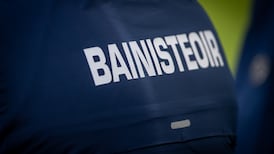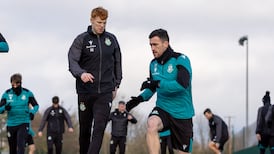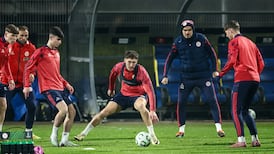Every so often, the New Zealand rugby team journeys to the upper reaches of the globe just to confirm there is nowhere to match the islands on the Tasman Sea. They visit the sights, win a few international matches on frosty afternoons, and fascinate and frighten all and sundry by performing the most frightening dance ever seen in public – at least since Brian Cowen led the last Fianna Fáil cabinet in a frenzied version of the Hucklebuck during the emotional hours of the annual convention.
It has become commonplace to question whether it is fair to allow the best rugby nation on earth to pretty much own the day before it even begins by issuing all kinds of dark promises and screams in the direction of their opponents. Does the haka give the All Blacks an advantage they hardly need? Does it promote mutual respect? Should white New Zealanders really be performing it?
Who gives a toss? The haka is brilliant.
Most fans know that when they buy a ticket to watch their team play against the All-Blacks, they will lose; the deal is you get to see the supreme innovators in rugby at their best and a vivid depiction of precisely where your own team stands in the pecking order. On top of that, you get to sit back and enjoy one of the last examples of a sport trusting the teams alone to create the atmosphere.
Even amidst the glare of advertising and floodlights of the modern amphitheatre, the haka continues to evoke primal images and the notion that these rugby players are the descendants of some pretty fearsome cats.
Genuinely chilling
It is surprising how formal the English translations of the haka verses prove to be, but everyone watching understands it is not so much what is being said as how it is being said. The message is entirely visual, emotive and unmistakable: we are bigger than you, we are tougher than you and you are lucky it's just rugby we are playing here and you're gonna get your ass kicked.
The performance predates the fabled New Zealand Originals tour of 1905 and is such an ingrained part of their rugby culture the idea of abandoning it is like suggesting they should no longer wear black or should pick a useless number eight. On ordinary days, the haka is merely ominous but at its best – depending on the challenge and the attitude of the crowd – it is genuinely chilling.
So the big debate for opposing teams is how best to respond to the challenge of the haka. What do you do when you have to stand in front of 15 stacked and pumped New Zealanders marching towards you in unison, screaming blue murder in an exotic tongue, tongues thrust out, eyes bulging and intent on wiping you off the face of the earth? The common response has been for other teams/countries to stand shoulder to shoulder and try not to look scared as ****. The problem is there isn’t much else they can do.
Willie Anderson’s 1989 team wrote themselves into rugby history when they played Buck Shelford’s visiting New Zealand team that autumn and famously slow-marched into the teeth of the fury so that by the end Buck and Big Willie were getting up close and personal. It was a wonderfully exciting moment . . . if only because it was so unexpected. Perhaps the most thrilling part of it was it was clearly thought out and rehearsed – not virtues associated with Irish teams of that time.
Even when you watch it on playback, you can sense the Irish crowd were stirred and engaged by the insurrection. But at the same time, everyone knew it was as doomed as the moment Newman and Redford decide to make a bolt for it at the end of Butch Cassidy. The New Zealanders looked mildly surprised and then Anderson raised his arms aloft and flapped his massive hands furiously, like a stork in distress. He was demanding more from the crowd but for a second it seemed as if he had realised the enormity of his error and was trying to make himself airborne. It was a glorious moment and then New Zealand won anyhow.
The coolest response
Anderson's moment lived and lives because it remains the coolest response in international rugby. There have been other famous reactions – David Campese decided he couldn't be arsed and kicked a ball when the teams met in 1991 and England's Richard Cockerill went on a daft solo mission into the midst of the haka in 1997.
There was much ado about the Welsh a few years ago, when they stood stony-faced as the All-Blacks went through a wickedly intimidating version of their dance and then remained absolutely still and in line for a full minute after it concluded.
What followed was an international staring match. “Like statues,” Eddie Butler marvelled at the Welsh poise. In the end, referee Jonathan Kaplan had to instruct the teams to break away, shooing at the Welsh as he might a border collie.
But still the Welsh men stayed put -perhaps for a mite too long. For the crowd, it is always difficult to figure out if opposing players are trying to look hard and undaunted by the All-Blacks or if they are just overcome and stricken with terror. Both, one suspects.
Part of the genius of the All-Blacks is they have made famous legions of stories which illustrate their unfathomable physical toughness. It all contributes to the perception they are more or less unbeatable. They have their opponents beaten before a ball is kicked. It was fascinating to hear Neil Francis, veteran of many an Irish rugby defeat, telling the good folk at Second Captains not only was it hard to handle the physical and rugby prowess of the New Zealanders, it was also difficult to tolerate “the yapping”.
It was discouraging to learn the All Blacks – usually polite and clipped in their utterances – were capable of outtalking a group of Irishmen. On the rugby field, they are indomitable in all sectors.
High point and low moment
So brave Ireland face the latest All-Black challenge tomorrow. Confidence is low. Memories of last year's 60-0 trashing are fresh. The task seems as impossible as ever. Playing the All-Blacks can often represent in one afternoon both the high point and low moment in the careers of Irish rugby players.
Sometimes the best of it is contained within the prelude, when the teams line up and a low murmur of anticipation travels through the crowd and the first blood-curdling words ring out, words designed to make opponents wish they were anywhere else even if, as rugby players, there is nowhere they would rather be.
Time to face the music – not to mention the snarling, the incantations, the scary faces and the grim fact the All Blacks are usually as good as their word.











